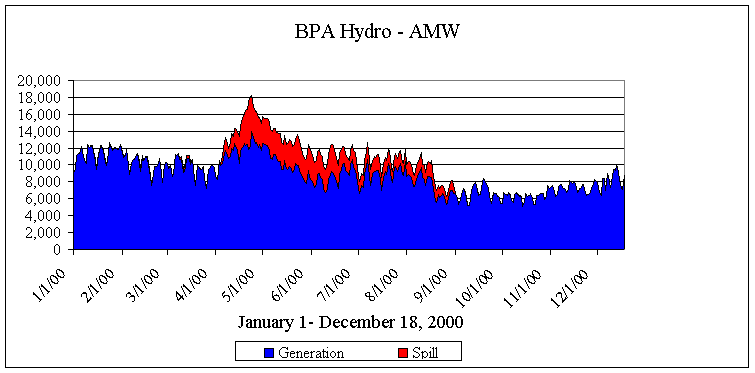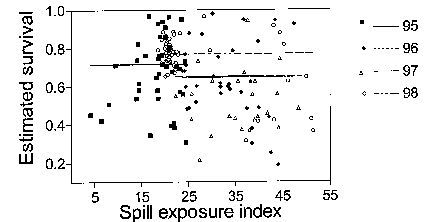News from the Front #40: The Environmentalist Energy Crisis
Communist governments everywhere teach again and again that centralized economic planning brings economic disaster. That doesn't stop our politicians, however, who have saddled the Pacific Northwest with a Northwest Power Planning Council, a Department of Energy, and regulators in every state to plan energy policy. After the first, pre-environmentalist generation of planners went beserk and lead the charge to construct more nuclear power plants than the Northwest could use (WPPSS aka "whoops"), the next generation of environmentalist planners has taken the opposite approach. For a long time, they have made it almost impossible to build new power plants, and they are destroying the ones we do have. And now we are running out of electric power.
If you believe the newspapers, it must have been "deregulation" that stopped us from building all those power plants, and whittled away at the ones we had. And if you believe the newspapers, more government planning and regulation will solve the problem, especially by forcing us to conserve power. (This is government's favorite way to "solve" the problems it creates when it creates shortages--ration out what's left.) "Wear a sweater and throw another blanket on the bed," says the Seattle Times, as if that could make a significant dent in the deficits the planners have wrought.
As usual, the newspapers are dead wrong. Unless you read that the government is going to build more power plants, or let the ones we have generate more power--don't hold your breath--the government is part of the problem, not part of the solution.
Here in the Pacific Northwest one of the biggest problems is the gradual destruction of the hydropower system, on the theory that it will "save the salmon". In particular, the fish fanatics believe that we must spill immense quantities of water over the tops of the dams to "save the salmon". The result is an incredible waste of electric energy, as one can see by comparing the energy generated by BPA in 1990 (top graph) with the energy generated in 2000 (bottom graph). Energy generated is blue, energy wasted, or spilled, is red:


(The charts are courtesy of RCS; AMW means average megawatts. These two years were selected for comparison because water conditions were similar: the spring runoff was 99.9 million acre-feet for 1990 and 97.9 million acre-feet for 2000.)
All the spill last year did not come cheap. BPA could have sold it for $600 million. Instead, it spent enormous sums buying power to make up the deficit. The ratepayers (you and I) pick up the tab.
What sort of public benefits might have accrued to justify spending all this money? There is good reason to believe that salmon survival over a sixty-foot spillway is slightly higher than survival through a turbine, but not by much. It doesn't take much spill to pass most of the fish over the top of a dam; more spill is mostly wasted. At The Dalles Dam, researchers found higher spill produced lower survival.
When the National Marine Marine Fisheries Service tried to measure net improvements in survival for salmon migrating during periods of higher spill over a reasonable length of the river system (specifically, from Lower Granite Dam to McNary Dam), they could find no relationship between spill and survival at all:

The most likely result is that the enormous fish-driven spill increases since 1990 produced no additional fish whatsoever. They may even have killed salmon. Early on in the spill program, they put baby salmon in net pens below the dams to see whether there were adverse effects from high spill. The salmon died, so they don't do that experiment any more.
Now if we had government officials who had any interest in solving the electricity crisis, there is a simple way to get more electricity for the Pacific Northwest. When they built the dams, they left many empty “bays” for future installation of additional turbine generators. There are four empty bays at John Day Dam, each of which was designed for installation of 135 megawatt turbines. There are three empty bays at Dworshak Dam (which doesn’t even have salmon or steelhead migrating past it), each of which was designed for 220 megawatt turbines. That’s 1,065 megawatts of power just from bolting in these six turbines.
Beyond that, the Corps of Engineers has long known that it makes good engineering sense to add a second powerhouse to McNary Dam and perhaps others, for even more power. Newer, fish-friendly turbines can produce even more power at all the dams, because they are more efficient. But instead of maintaining and improving hydropower assets, the Corps fiddles with fish follies while facilities fail.
You won't read anything in the newspapers suggesting that we generate more power with the Pacific Northwest's abundant, renewable hydropower. The prevailing view of the environmentalists that infest our government agencies is that we should just shut down energy-intensive industries in the Pacific Northwest, pursuing a de-industrialization strategy with dark ramifications for America's future welfare. High-energy prices don't just wipe out aluminum plants and steel mills and cold storage facilities. Energy is a primary input into all sorts of industries, such as fertilizer and many other chemicals. The fabled "new economy" based on computers goes nowhere without electricity.
The environmentalists seem to regard economic growth as inherently evil, so that the disasters that result from centralized planning are a good thing. Higher energy prices destroy industry, but industry is bad. Higher energy and higher fertilizer prices help drive farmers out of business, but that restores Nature's perfection.
Our energy planners and regulators are like termites destroying the posts and beams that hold up our economy. And the worst part is that it's not just salmon and energy policy. Termites deny the importance of truth in education, and teach that everything is relative and arbitrary. Termites deny the value of America as melting pot, and push for racial and tribal classifications that cause conflict. Termites deny the importance of America living within its means, and write IOUs to foreigners with our money. Termites deny the importance of national sovereignty and even national security, and favor control by a UN hostile to American values. The resulting rot is getting more and more serious, and if America doesn't start pest control soon, it's going to be in real trouble. What are you doing about it?
© James Buchal, January 5, 2001
You have permission to reprint this article, and are encouraged to do so. The sooner people figure out what's going on, the quicker we'll have more fish in the rivers.
![]()
Return to Other Salmon Materials
Return to www.buchal.com